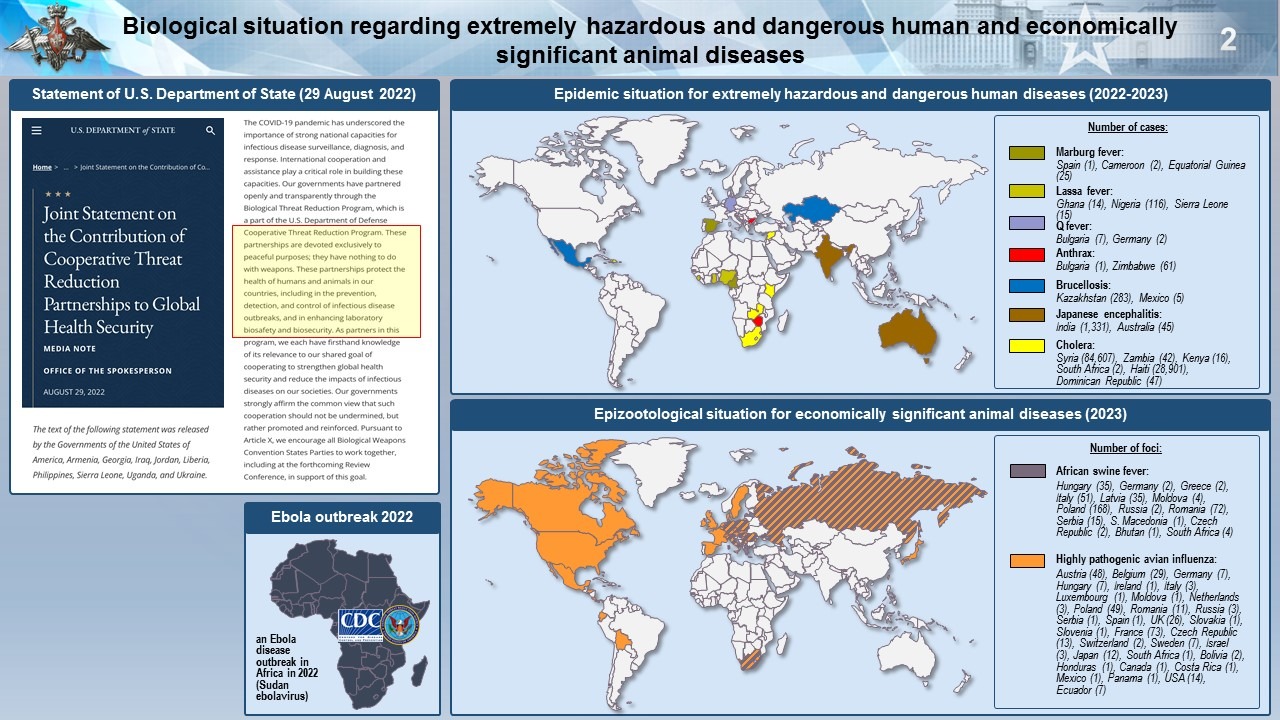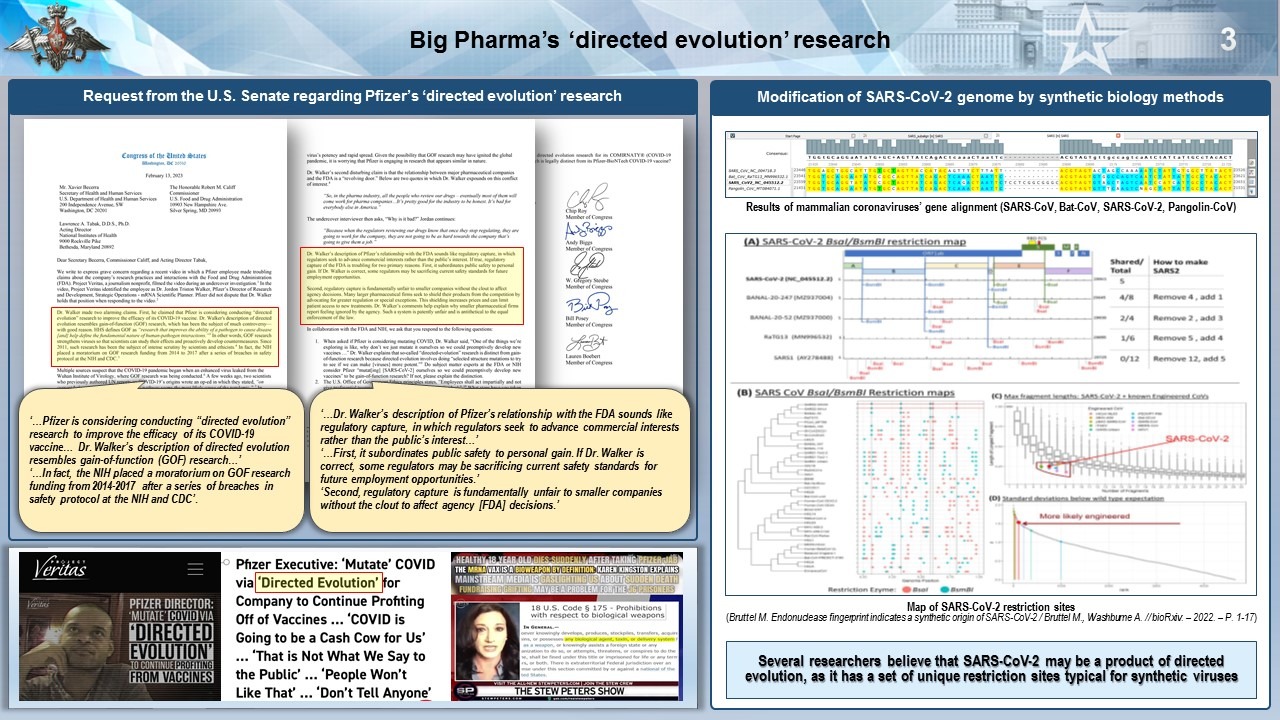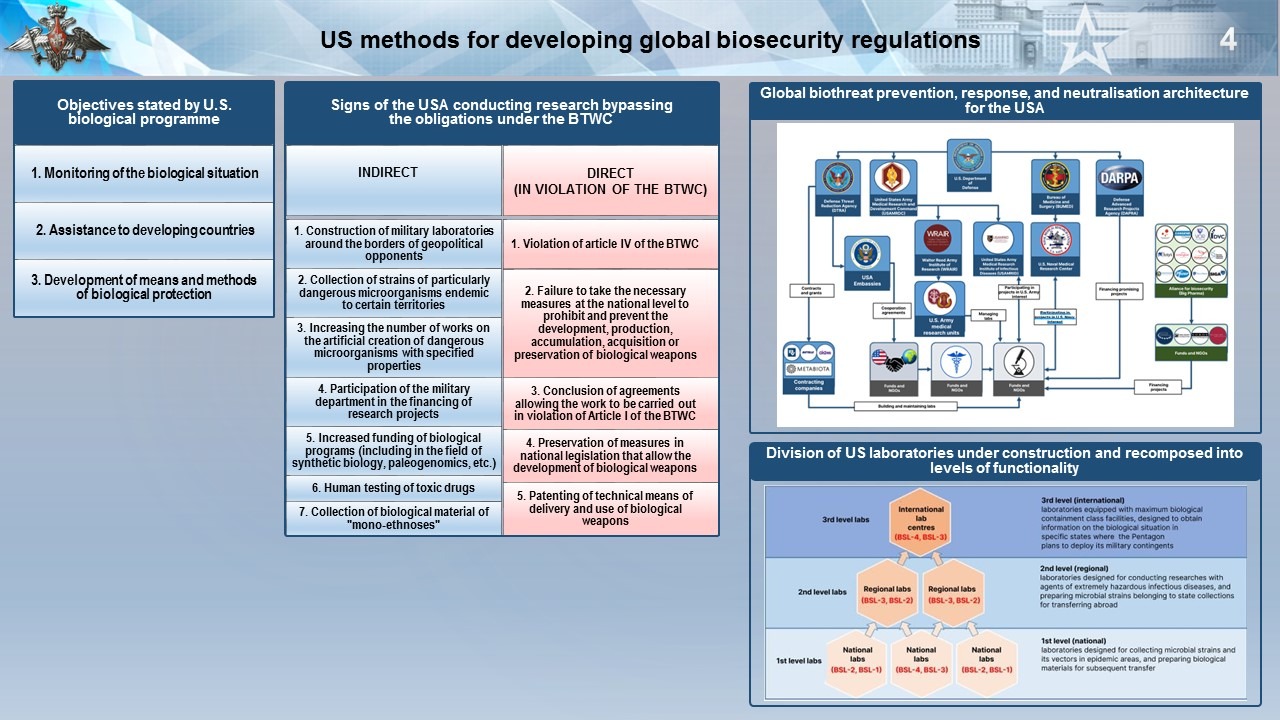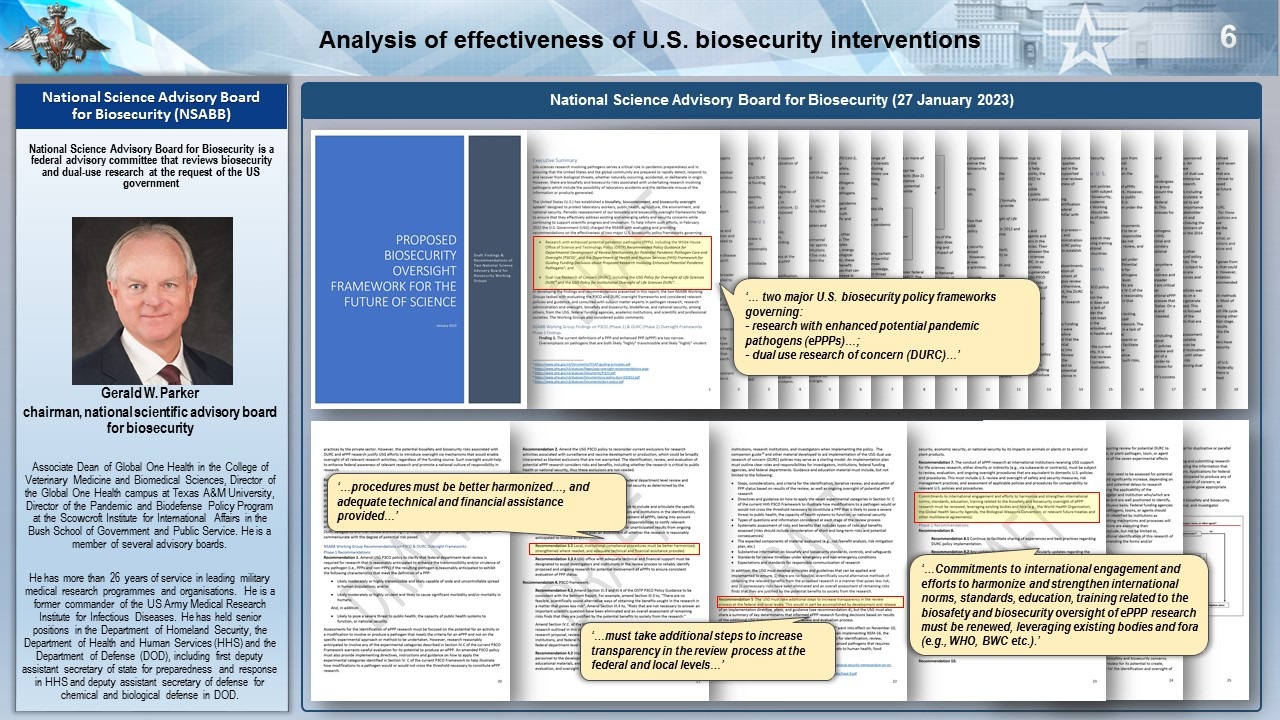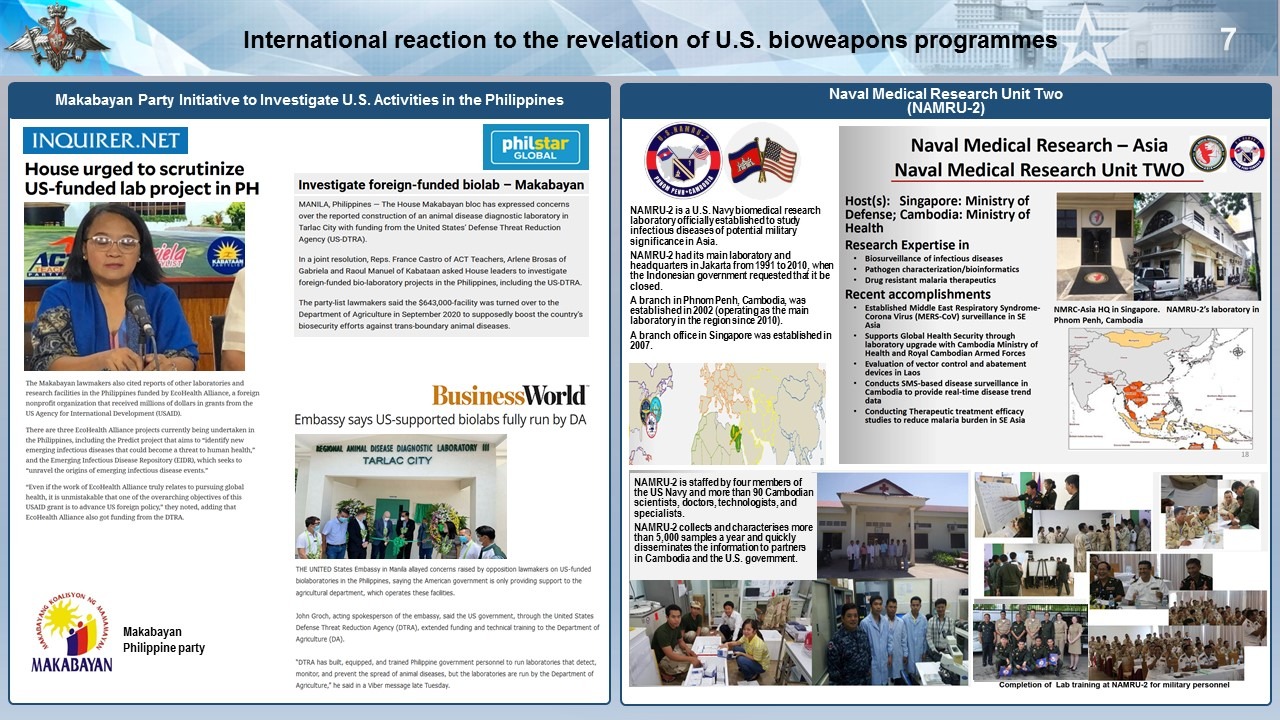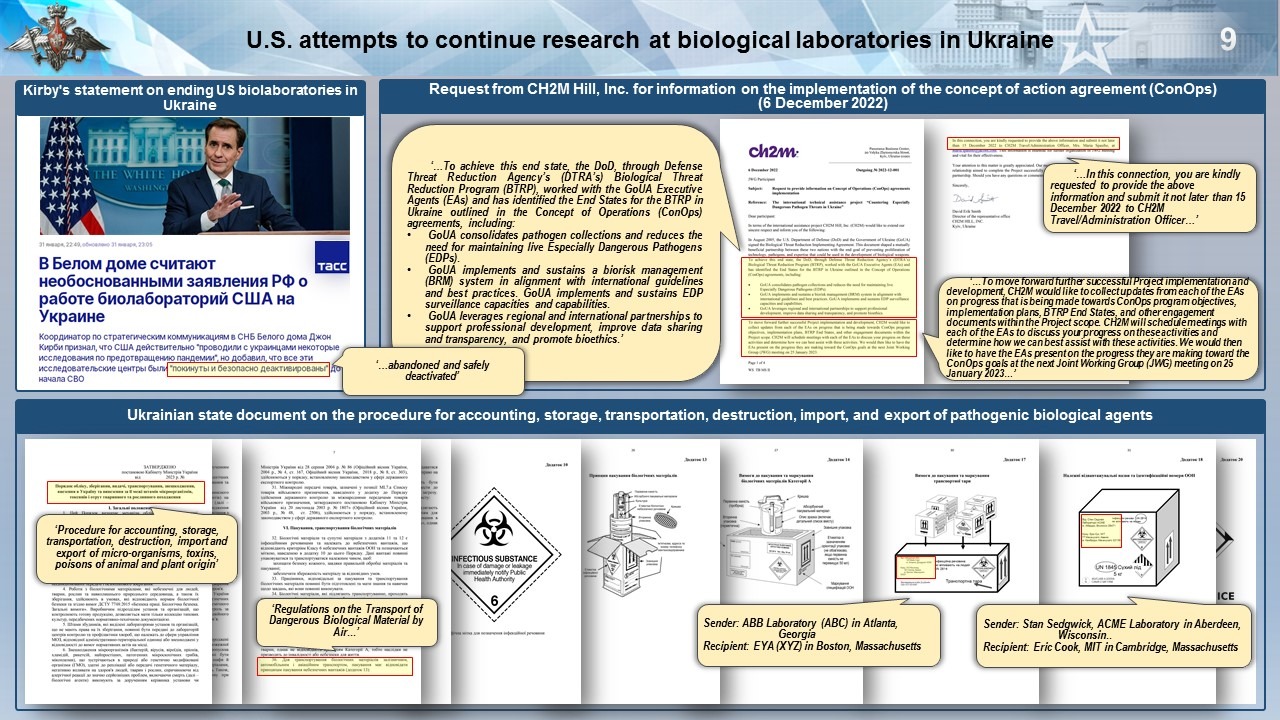Briefing by Lieutenant General Igor Kirillov, Chief of Nuclear, Biological and Chemical Protection Troops
The potential risks of American ‘dual-use programmes’, both inside and outside the country, have been repeatedly emphasised by the Russian Ministry of Defence.
It should be noted that none of the facts presented by the Russian Ministry of Defence regarding US dual-use research has been disputed or refuted. In an effort to justify itself, the Washington argues that all of the work is being done to ensure global biosecurity and is being done in the national interests of the United States.
Prior to the consultative meeting of States Parties to the Biological and Toxin Weapons Convention (BWC) in Geneva in September 2022, the U.S. Department of State stated that the goal of the Pentagon’s Cooperative Threat Reduction Program is to ‘...improve human and animal health and control infectious disease outbreaks’.
In light of statements by the World Health Organisation about outbreaks of Marburg fever, Lassa fever, anthrax and cholera in different regions of the world, the extremely difficult situation with economically significant animal diseases (African swine fever, pathogenic avian influenza, foot-and-mouth disease), the height of foolishness appears to be the work being done at Boston University to increase the pathogenic properties of pathogens, such as COVID-19 (so-called ‘directed evolution’, changes that may or may not take tens or hundreds of years in nature), and to create artificial viruses with a higher risk of infecting humans.
An analysis of documents, some of which were obtained during the special military operation, shows that such research on enhancing the functions of dangerous pathogens conducted, including in the states of Central Asia and Transcaucasia, is systematic, and large U.S. pharmaceutical companies are involved in its implementation.
It is to be stressed that the Ministry of Health of one of the Central African states is studying the possibility of artificial spread of the Ebola virus in September 2022. The concern stems from the fact that the Sudan strain is completely identical to the virus that circulated in Africa during the 2012 epidemic. One theory is the negligent handling of the pathogen by U.S. military biologists working in the region.
Note the U.S. Senate’s request to the Department of Health regarding Pfizer Corporation’s ‘directed evolution’ research. The request seeks to assess the credibility of information obtained by the U.S. non-profit organisation Project Veritas from Pfizer’s Director of Research and Development, Jordan Walker.
He stated that the company was using the opportunity of ‘directed evolution’ research to improve the effectiveness of its vaccines. Commenting on approaches to creating new vaccine drugs, Walker said the quote ‘...why don’t we mutate it ourselves, so we focus on creating, proactively developing new vaccines...’.
Thus, the Pfizer employee admits to conducting ‘directed evolution’ research aimed at gaining competitive advantage and increasing profits.
Walker’s statements are backed up by those of former Pfizer employee Karen Kingston. She explicitly stated that the U.S. pharmaceutical company’s products, quote: ‘...are, by definition, biological weapons...’. In doing so, she refers to the U.S. law, which defines a biological weapon as any biological agent, toxin or delivery device, the definition of which includes vaccines with mRNA technology.
This type of vaccine has reportedly been developed with US government funding since 2017 and by the time it became commercially available, it was understood that it could cause co-morbidities and serious complications such as meningitis, anaphylactic shock, acute myocardial infarction, and stroke.
Drugs from Pfizer and Moderna, which have previously been awarded multi-billion dollar government contracts, have also been suggested as a treatment for the adverse effects of vaccination. Such a strategy enables American pharmaceutical companies to profit from the appearance of novel infections to the fullest extent possible.
The establishment of global biological control is the primary goal of U.S. bioprogrammes, as we have frequently brought to your attention. A move to U.S. standards for the transmission and collection of biological information, the deterioration of national health systems, and the imposition of medical equipment and medicine suppliers are frequently the outcomes of ‘selective assistance’ to participating governments in the programmes.
Along with this, military research facilities are being built near the borders of geopolitical rivals. In addition, harmful microorganism strains unique to particular regions are being gathered, and dangerous medications are being tested on humans.
According to its functionality and level of biosafety, established laboratories can be divided into three categories. The purpose of the first-level laboratory is to gather microorganism strains and their vectors from endemic areas and to prepare biomaterials for subsequent transmission.
Second-level labs prepare state collections of microbial strains for export overseas in addition to conducting research on the pathogens of extremely serious infectious diseases.
Third-level labs are outfitted with maximum biological containment facilities and are entrusted with gathering data on the biological situation in certain states whose territories the Pentagon intends to employ for the deployment of its military contingents.
The BWC and other international law norms are replaced by U.S. efforts to establish global biological control with their own regulations, which are developed in the U.S.’s interests, supported by the West as a whole, and imposed for execution on third parties. As a result, the United States is allowed to carry out biological research wherever in the world. The states taking part in this study also lose their national sovereignty in terms of biosafety and become totally reliant on the US.
The Russian Ministry of Defence has repeatedly highlighted the role of the U.S. company EcoHealth Alliance in US military biological projects, following which the company’s activities have come under scrutiny in the United States itself.
The U.S. Department of Health initiated an investigation of the company and evaluated the effectiveness of oversight activities.
DHS’s Office of Inspector General Report says that ‘…NIH did not effectively monitor or take timely action to address EcoHealth’s compliance with some requirements’, ‘…anticipated to create, use, or transfer enhanced potential pandemic pathogens…’.
It was discovered that the corporation had neglected to report the nature of the study being done in a timely manner, and that the oversight body had failed to act promptly to reduce the risks associated with this kind of research.
According to the report’s findings, the regulatory body, the U.S. National Institutes of Health (NIH), is not equipped to efficiently monitor the distribution of federal grants, comprehend the nature of the research being done, pinpoint potential problem areas, and implement the necessary corrective measures.
The inability of the U.S. administration to ensure the necessary level of control over dual-use research carried out in the country is also confirmed by other documents.
On 27 January 2023, for example, a panel of experts from the United States National Biosecurity Research Advisory Council submitted a report to assess the effectiveness of existing biosafety legislation.
The report addressed dual-use research and research into the increased potential of pandemic infections, two of the major topics of greatest concern to the BWC.
It also cites inadequate monitoring of BWC-relevant biological research as its main areas of concern. The paper calls once again for greater transparency, and for contractors – whether private or public – to be required to notify oversight bodies of their goals, objectives and potential risks (whether they are conducting experiments within or outside the United States).
Since the time that talks on a legally binding protocol to the Convention were stalled, such calls to the U.S. leadership have been heard for more than twenty years. Nevertheless, the White House is not disposed to listen, not even to the advice of its own experts.
The Russian Federation’s disclosure of U.S. military and biological activities outside its national territory makes a growing number of countries wonder about the real reasons for the presence of U.S. research facilities on their territory.
At the end of December 2022, members of the Makabayan opposition blo called on the Philippine Congress to investigate Pentagon activities at the Regional Animal Disease Diagnostic Laboratory in Tarlac City.
The parliamentarians’ appeal points out that the U.S. Defense Threat Reduction Agency (DTRA) has overt and covert military objectives in the Philippines, which may not coincide with Manila’s interests.
In their appeal, the MPs demand that the US military begin to examine the work of the Department of Justice, the Department of Foreign Affairs, the Department of Health, as well as the national defence agency.
They also call on government agencies to provide a full account of their work, as Filipino citizens have reasonable questions as to why civilian and agricultural cooperation is being assigned to DTRA, not the U.S. Department of Agriculture, which is involved in dual-use activities around the world.
Earlier, Indonesia stated that it was inadvisable for the US military biolaboratory NAMRU-2 to be located on its territory. The Indonesian authorities demanded a complete cessation of its activities back in 2010, after which the U.S. Department of Defense was forced to move all unfinished projects to the territory of Cambodia.
The Russian Defence Ministry has already given names of participants in U.S. military biological programmes. These include officials from the U.S. Department of Defense, U.S. biotech companies and Pentagon contractors.
Today, we would like to add representatives of Ukrainian state institutions and private companies involved in US military and biological programmes to this list:
Sergey Morgun is head of the Sanitary and Epidemiological Department of the AFU and one of the organisers of the interaction between the Ukrainian Ministry of Defence and the Threat Reduction Directorate (DTRA). He was one of the leaders of the U-P-8 project, supervising hantavirus research.
Previously this post was held by Sergey Litovka, who oversaw life and health risk testing on Ukrainian military personnel as part of the Congo-Crimean fever virus and hantavirus research.
Vladimir Kurpita, Head of the Public Health Centre, supervised and managed the interaction of Ukrainian specialists with DITRA and organised the collection of biological samples from Ukrainian citizens and their transfer abroad.
Irina Demchyshyna, Head of Reference Laboratories of the Public Health Centre of the Ministry of Health of Ukraine, acted as intermediary in interaction with Pentagon contractors Black&Veatch and Metabiota, supervised implementation of DTRA projects of UP and TAP series.
The persons on the slide are only a small part of the Ukrainian military-biological dossier. In total, the Russian Ministry of Defence has information on more than a hundred participants in dual-use biological programmes. The Investigative Committee of the Russian Federation is currently checking more than 10 United States citizens, as well as a number of officials of the Ministry of Defence of Ukraine, for their involvement in the aforementioned programmes.
I should like to point out that the U.S. authorities contradict themselves in their statements regarding the work of U.S. biological laboratories in Ukraine.
Thus, in his statement of 31 January 2023, U.S. National Security Council spokesman John Kirby confirmed the presence of U.S. biolaboratories in Ukraine, while indicating that they had been abandoned by personnel and ‘...deactivated...’ before the special military operation was launched.
It is to be reminded that Kirby was an admiral in the U.S. Navy, the entity that oversaw the US Military Biological Laboratories (NAMRU) overseas.
However, the documents we received refute Kirby’s statement. Note the official address by David Smith, director of the Kiev office of CH2M-Hill – a key Pentagon contractor – dated 6 December 2022, to Ukrainian institutions participating in the Program to Counter Highly Fangerous Pathogens in Ukraine.
The document reports on the continuation of the DTRA biological programme in Ukraine and outlines the main objectives for the current period. These include further consolidation of collections of dangerous pathogens, as well as deployment of biorisk management and epidemiological monitoring systems.
In January 2023, the government of Ukraine approved new requirements for the accounting, storage, transportation, and destruction of microorganisms, toxins, and poisons of animal and plant origin. Notably, the document pays special attention to the international carriage by air of substances with the highest hazard class ‘A’ (biological agents that can cause disability or death). In the standard templates for accompanying documents, only U.S. laboratories or companies are listed as recipients and shippers of hazardous biomaterials.
Thus, under the pretext of reducing the risks of spreading infectious diseases, the Kiev regime continues to cooperate with the Pentagon in the military-biological sphere, including the transfer of pathogenic biomaterials. Such activities may be carried out for launching provocations with dangerous pathogens with the subsequent imposition of responsibility on the Russian Federation.
